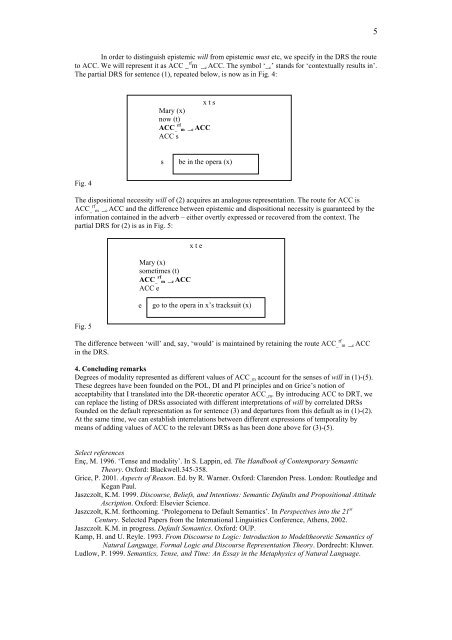SemPrag03.Progr.pdf - Institut für Linguistik/Germanistik - Universität ...
SemPrag03.Progr.pdf - Institut für Linguistik/Germanistik - Universität ...
SemPrag03.Progr.pdf - Institut für Linguistik/Germanistik - Universität ...
You also want an ePaper? Increase the reach of your titles
YUMPU automatically turns print PDFs into web optimized ePapers that Google loves.
5<br />
In order to distinguish epistemic will from epistemic must etc, we specify in the DRS the route<br />
to ACC. We will represent it as ACC _ rf m _ c ACC. The symbol ‘_ c ’ stands for ‘contextually results in’.<br />
The partial DRS for sentence (1), repeated below, is now as in Fig. 4:<br />
x t s<br />
Mary (x)<br />
now (t)<br />
rf<br />
ACC _ m _ c ACC<br />
ACC s<br />
s<br />
be in the opera (x)<br />
Fig. 4<br />
The dispositional necessity will of (2) acquires an analogous representation. The route for ACC is<br />
ACC _<br />
rf<br />
m _ c ACC and the difference between epistemic and dispositional necessity is guaranteed by the<br />
information contained in the adverb – either overtly expressed or recovered from the context. The<br />
partial DRS for (2) is as in Fig. 5:<br />
Mary (x)<br />
sometimes (t)<br />
ACC _<br />
rf<br />
m _ c ACC<br />
ACC e<br />
x t e<br />
e<br />
go to the opera in x’s tracksuit (x)<br />
Fig. 5<br />
The difference between ‘will’ and, say, ‘would’ is maintained by retaining the route ACC _<br />
rf<br />
m _ c ACC<br />
in the DRS.<br />
4. Concluding remarks<br />
Degrees of modality represented as different values of ACC _m account for the senses of will in (1)-(5).<br />
These degrees have been founded on the POL, DI and PI principles and on Grice’s notion of<br />
acceptability that I translated into the DR-theoretic operator ACC _m . By introducing ACC to DRT, we<br />
can replace the listing of DRSs associated with different interpretations of will by correlated DRSs<br />
founded on the default representation as for sentence (3) and departures from this default as in (1)-(2).<br />
At the same time, we can establish interrelations between different expressions of temporality by<br />
means of adding values of ACC to the relevant DRSs as has been done above for (3)-(5).<br />
Select references<br />
Enç, M. 1996. ‘Tense and modality’. In S. Lappin, ed. The Handbook of Contemporary Semantic<br />
Theory. Oxford: Blackwell.345-358.<br />
Grice, P. 2001. Aspects of Reason. Ed. by R. Warner. Oxford: Clarendon Press. London: Routledge and<br />
Kegan Paul.<br />
Jaszczolt, K.M. 1999. Discourse, Beliefs, and Intentions: Semantic Defaults and Propositional Attitude<br />
Ascription. Oxford: Elsevier Science.<br />
Jaszczolt, K.M. forthcoming. ‘Prolegomena to Default Semantics’. In Perspectives into the 21 st<br />
Century. Selected Papers from the International Linguistics Conference, Athens, 2002.<br />
Jaszczolt. K.M. in progress. Default Semantics. Oxford: OUP.<br />
Kamp, H. and U. Reyle. 1993. From Discourse to Logic: Introduction to Modeltheoretic Semantics of<br />
Natural Language, Formal Logic and Discourse Representation Theory. Dordrecht: Kluwer.<br />
Ludlow, P. 1999. Semantics, Tense, and Time: An Essay in the Metaphysics of Natural Language.

















